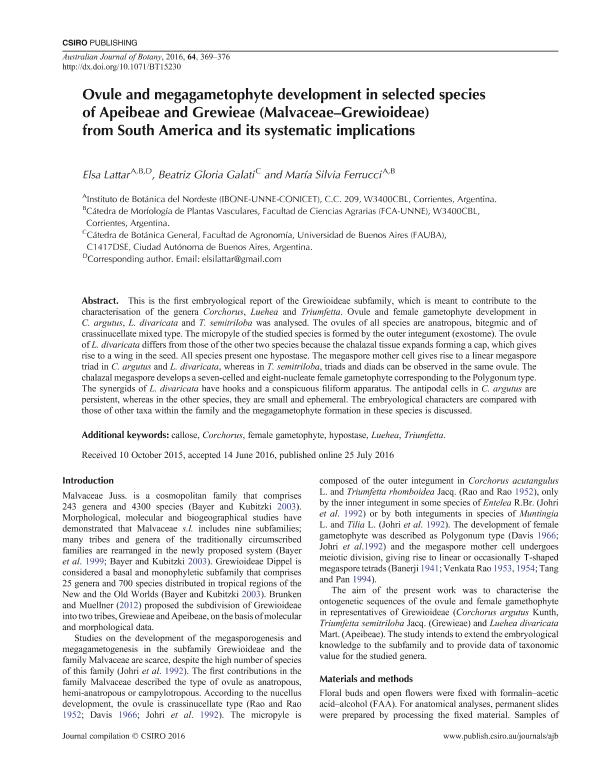Artículo
Ovule and megagametophyte development in selected species of Apeibeae and Grewieae (Malvaceae–Grewioideae) from South America and its systematic implications
Fecha de publicación:
08/2016
Editorial:
Csiro Publishing
Revista:
Australian Journal of Botany
ISSN:
0067-1924
e-ISSN:
1444-9862
Idioma:
Inglés
Tipo de recurso:
Artículo publicado
Clasificación temática:
Resumen
Ovule and female gametophyte development in C. argutus, L. divaricata and T. semitriloba was analyzed. The ovules of all species are anatropous, bitegmic and crassinucellate mixed type. The micropyle of the studied species is formed by the outer integument (exostome). The ovule of L. divaricata differs from those of the other two species because the chalazal tissue expands forming a cap, giving rise to a wing in the seed. All species present one hypostase. The megaspore mother cell gives rise to a linear megaspore triad in C. argutus and L. divaricata, whereas in T. semitriloba, triads and diads can be observed in the same ovule. The chalazal megaspore develops a seven-celled and eight-nucleate female gametophyte corresponding to the Polygonum type. The synergids of L. divaricata have hooks and a conspicuous filiform apparatus. The antipodal cells in C. argutus are persistent, whereas in the other species, they are small and ephemeral. This is the first embryological report of the Grewioideae subfamily, which contributes to the characterization of the studied genera. Then compare to the data known for the family are inferred embryological characters for the group.
Palabras clave:
Grewioideae
,
Development
,
Female Gametophyte
,
Malvaceae
Archivos asociados
Licencia
Identificadores
Colecciones
Articulos(IBONE)
Articulos de INST.DE BOTANICA DEL NORDESTE (I)
Articulos de INST.DE BOTANICA DEL NORDESTE (I)
Citación
Lattar, Elsa Clorinda; Galati, Beatriz Gloria; Ferrucci, María Silvia; Ovule and megagametophyte development in selected species of Apeibeae and Grewieae (Malvaceae–Grewioideae) from South America and its systematic implications; Csiro Publishing; Australian Journal of Botany; 64; 5; 8-2016; 369-376
Compartir
Altmétricas




